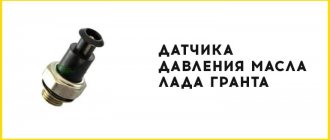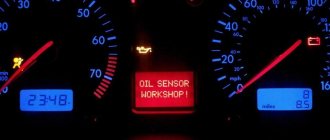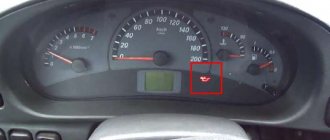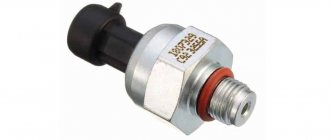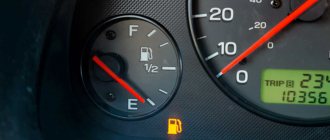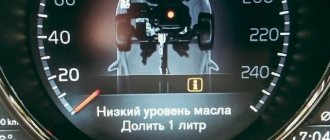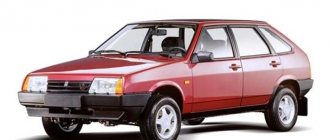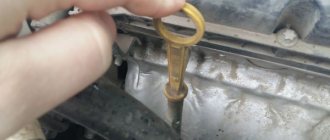The engine lubrication mechanism works to supply automobile oil to the moving parts of the power unit under pressure created by the oil pump. If for various reasons a drop in engine oil pressure occurs, the lubricant will not be able to reach all parts of the unit, which can lead to its breakdown. Therefore, to constantly monitor the level of lubricant pressure, a sensor (light) is located on the dashboard of the car, which, in the event of a malfunction, sends a signal to the driver.
If the oil pressure light comes on while the engine is warm, the driver should quickly stop the car and take all measures to eliminate the problem.
What happens when the oil pressure light comes on on a warm engine?
If problems arise with the pressure level, the engine begins to experience the following problems:
- lack of lubricant;
- wear of moving parts increases;
- the heating of the engine as a whole increases;
- engine cleaning from soot and various deposits is reduced;
- malfunction with subsequent breakdown of bearings;
- Noise in the engine housing increases.
All of the problems listed above ultimately lead to jamming and engine failure.
Possible reasons why the oil pressure sensor lights up
The problem is very common and can occur at any time. Drivers often show disdain when the sensor light comes on. For some reason, motorists think that this is a malfunction of the LED and do not take any measures.
In fact, if the light comes on, it means there is a violation and it is important to take quick action. First you need to determine the reason why the malfunction occurs. These include:
- malfunction of the oil pressure sensor;
- low quality of filled oil lubricant;
- inconsistency of the lubricant composition with the tolerances for a particular engine;
- a decrease in the level of lubricant as a result of a leak or increased consumption, for example, the lubricant is wasted or there are problems with the rings or valve stem seals;
- according to its characteristics, the lubricant is not suitable for use - the viscosity level is too high or too low;
- the oil pump is faulty or its performance is reduced;
- the oil filter and channels are clogged with deposits, as a result, it is not possible to create the required level of lubrication in the system.
From the above, it is important to take into account one thing - when the emergency pressure reduction light comes on, it means that the problem is obvious and needs to be solved. There is one significant point - the sensor can light up “cold” or “hot”.
Diagnosing oil pressure problems
Checking the engine oil level . The cause of the problem may be a small amount of lubricant in the unit.
The reason for the decrease in level may be:
- through damage to the oil pan;
- increased engine consumption due to severe wear;
- increased oil consumption due to waste;
- wear or improper operation of the oil pump.
Having such problems, you need to immediately tow the car to the nearest service station to eliminate the above problems.
Simply adding oil to the required level will not solve the problem. Replacement with lubricant of optimal viscosity . Each brand of car has its own brand of lubricant that must be used during its operation. For example, using 0W20 oil instead of 5W40 leads to severe dilution of the lubricant, since the lubricant used does not comply with the car manufacturer’s recommendations in the manual. This situation can lead to leaks of engine gaskets and seals, which is guaranteed to lead to a decrease in the engine oil level and a drop in its pressure. To avoid getting into such a difficult situation, you need to carefully select the viscosity indicator and other main indicators.
Good to know: Is it possible to add oil to an engine of another brand?
Timely replacement according to the kilometers traveled. It is important to remember that oil may simply lose its protective properties after a certain period of time. It is recommended to replace it after 10-14 thousand km.
Good to know: When should you change the engine oil based on mileage or once a year | How long does it take to change the engine oil
Undesirable mixing with antifreeze. Such troubles can arise from cracks in the cylinder block or from a breakdown of the cylinder head gasket. When antifreeze is mixed with oil, the chemical properties of lubricants change and deteriorate. The first sign of such problems is the presence of an emulsion on the surface of the oil dipstick.
Fuel getting into the engine oil. This problem can arise when the ignition and subsequent combustion of fuel in the engine cylinder is disrupted. As a result, fuel gets into the oil, which greatly dilutes it and leads to a drop in lubricant pressure.
Excessive abuse of various additives. Adding various additives to the oil can also lead to a loss of lubricant quality and ultimately lead to problems.
Good to know: Which motor oil is not counterfeited in Russia, list of the best
Wear of various engine parts. This situation may be caused by an increase in gaps between parts, resulting in a drop in engine pressure and excessive consumption of lubricant. Such problems need to be solved only with the help of a major overhaul of the unit. Various additives will only alleviate the situation temporarily.
Oil receiver filter clogged. If a sufficient amount of lubricant does not pass through this element, the engine will begin to feel a lack of lubricant with all the ensuing negative consequences. The filter may become clogged due to the fact that various types of contaminants have accumulated on the walls of the pan. To solve this problem, you need to clean the oil receiver filter from dirt, thereby solving the problem of engine oil passing through it.
Timely replacement of the oil filter. If the filter is not replaced with a new one in time, it may become clogged and this may ultimately cause a drop in pressure levels. In addition to clogging, the oil filter may be of poor quality, which will negatively affect the operation of the engine lubrication system.
Good to know: Do I need to fill the filter with oil when changing the oil?
Irregular operation of the pressure relief valve. The valve, by its design, remains closed until the pressure exceeds the required norm. But if the valve sometimes sticks in the open position and then it is impossible to obtain the required pressure.
Oil pump failure. If this element breaks down, it must be quickly replaced or repaired. After all, without proper and constant operation of the oil pump, it is impossible to ensure uninterrupted and high-quality lubrication of all rubbing engine parts.
How does the oil sensor work and why can it fail?
Now let's consider the situation if you are on the road and the low pressure indicator has triggered. The very first thing you need to do is stop the vehicle and turn off the engine. As soon as it cools down, you will have to check the lubricant level in the system. There is a special dipstick under the hood for this purpose. It is wiped dry and immersed in its original place. It is quite possible that the level will be below the minimum level. This means that somewhere there is a leak or depressurization of connections. You can set off again only after adding oil to the engine. If the lamp continues to light after starting and does not go out subsequently, it makes sense to think about towing the car to the nearest service station or to a trusted auto mechanic. The matter may turn out to be quite serious, so it is advisable to conduct the examination in a calm environment.
Since we have already said that the causes of low pressure may be associated with a faulty sensor, it would be useful to understand the principle of operation of this device. There are certain contacts inside it. Until the ignition is turned on, there is no pressure in the system, so the contacts are closed. When you turn the key and turn on the ignition, but before the starter starts, the warning lamp should be on. If this does not happen, then there may be some kind of malfunction. Maybe the light bulb itself simply burned out, or maybe the contacts were broken or the sensor itself failed. As soon as we start the engine, the contacts open, leading to the light bulb going out.
The role of the oil pressure indicator
The red light, marked on many cars with the image of an oil can, was added to the dashboard for a reason. It is connected to a common electrical circuit with a sensor mounted in one of the channels of the engine lubrication system. When the element detects a pressure drop below a critical level, the circuit closes and the lamp flashes red, informing the driver of an emergency malfunction.
The signal from the red lamp with the image of an oil can indicates a malfunction of the engine lubrication system
The purpose of the emergency lamp is to warn the car owner in time about the engine's oil starvation. If for various reasons it does not light up or the driver ignores the red “oil can” signal on the instrument panel, then the following consequences may occur:
- due to lack of lubrication, the crankshaft journals wear out, the sliding bearings (liners) may rotate and finally jam; As a result of oil starvation, wear appears on the crankshaft journals
- In the absence of oil, the piston skirts will overheat and expand in volume, leaving scratches and scuffs on the cylinder walls; A poorly lubricated piston heats up and leaves scuff marks on the cylinder wall
- the camshaft bearings located at the highest point of the engine will fail; Without lubrication, the camshaft bearings quickly fail
- the service life of the remaining rubbing parts will be sharply reduced.
Insufficient amount of lubricant or its absence in any case leads to breakdown and costly repair of the power unit. A timely signal on the dashboard will help avoid this.
Main reasons
- Minimum oil level. Today this reason is considered one of the most common. When using the vehicle regularly, it is recommended to carefully monitor the oil level and try to notice various drips on the engine body. Any, even the smallest oil stains under the car are sufficient reason to check the oil system.
- Using bad filters. A certain amount of oil should always remain in the filter, regardless of the stop of the power unit. This is required so that the effect of “engine oil starvation” does not form. As practice shows, many low-quality filters do not retain oil, so it flows into the crankcase without any problems. The only way to cope with this situation is to replace the filter with a better one.
- Wiring fault. Very often the oil pressure light stays on for a long time due to wiring problems. It is located on the panel and connected to the sensor via a wire. If the oil pressure drops below a certain level, the sensor closes the light to ground. When the pressure becomes normal, the contacts open and the light goes out. However, if the sensor itself is broken, the light will not turn off. In this situation, it is necessary to conduct a thorough diagnosis, replace the wiring, as well as parts that have failed.
- Reducing valve failure. If the pressure level is minimal, then the working pressure relief valve will be located in the closed position. If it freezes or gets stuck in the open position, the required pressure will not be generated in the system, and accordingly, the light will be constantly on.
- The pump screen is clogged. It is this part that is responsible for effectively protecting the pump, as well as the power unit, from the penetration of all kinds of debris onto various surfaces. Hard chips, dirt, dust and other objects - all this has a negative impact on the surface of numerous parts. If the oil is clean, free of all kinds of contaminants, then it easily passes through the mesh. At this moment, the sensor is set to a “quiet state,” which confirms the normal functioning of the motor. However, when the oil becomes dirty and moves poorly through the filter, it is not possible to provide the required pressure. To solve this problem, it is necessary to replace the oil pan.
- Oil pump failure. If this device cannot guarantee the pressure necessary for high-quality lubrication, then the contacts are closed, accordingly, the light will constantly signal to the driver that there is a fairly serious malfunction in his vehicle.
If the pressure light is dim, you should check the wiring or replace the light bulb itself.
You can learn about the oil pressure in your car from the article What is the oil pressure.
When can it light up on a warm or cold engine?
It happens that when you start the engine, the LED lights up and does not go out, or blinks regularly. With a warm engine idling, the pressure lamp will light steadily in the event of a breakdown. In fact, the control light is not an indicator of excellent quality of the smear and the presence of a sufficient level of the substance within the system. The main task of the sensor is to record the pressure level and lack of lubrication in the system. In other words, the LED will light up if the pressure in the system drops below a critical level.
It should be noted that short-term lighting of the light bulb (within a few seconds) is allowed. This happens before the engine starts and is normal. The oil pump should not maintain the required level, therefore, after turning off the engine, there is no pressure in the system. The required voltage appears after the starter begins to crank the crankshaft. Now, if after this the light does not go out and continues to blink, then it’s time to start looking for the cause of the malfunction.
It should be added that when the vehicle is stopped, the oil in the crankcase thickens (especially mineral water) and the oil pump needs time to increase the pressure level.
What does the lamp indicate?
The indicator light on the dashboard reacts strictly to engine oil pressure. Due to the level being reduced within reasonable limits, the signal will not appear on the panel. The exception is the loss of 2/3 of the lubricant when the oil intake of the pump begins to pick up air and crankcase gases. Then the pressure in the lubricating channels will inevitably drop, to which the sensor will react and the light will light up.
The oil receiver is specially installed at the bottom of the pan so that the system operates when there is a lack of lubrication
The circuit, signaling problems with lubrication of the power unit, consists of parts that also periodically break. So a flashing lamp does not always mean fatal engine failure. But if it lights up on your car, then you need to act like this:
- Stop moving.
- Turn off the engine.
- Check the lubricant level and, if necessary, add up to normal. The lubricant level in the car engine is checked with a special dipstick
- Topping up did not work - transport the car to the garage or to a car service using a tow truck or in tow.
- If the indicator light is intermittent (flashing), then move to the repair site under your own power at low speed. Monitor the coolant temperature gauge and pressure light: when it stops flashing and lights up, immediately turn off the engine.
In your garage, you can find the cause of the alarm if you follow the steps below.
The pressure light is on - what to do?
First of all, it’s worth understanding that you can’t take anyone’s word for it, much less the oil pressure sensor. Some older cars have two sensors, one for the hazard warning light and one for the pressure gauge.
Audi and Volkswagen cars of the 90s use a pressure monitoring system with two sensors and warning lamps. One pressure warning lamp lights up when the pressure is critically low, and the second when the pressure is critically high.
So, we figured out why the oil pressure is on, now let’s see what needs to be done about it. As already mentioned, we need to find out “if there was a boy.” To do this, we perform the following procedures:
We take a regular analog (dial) pressure gauge. We connect it instead of the pressure sensor. This can be done using an old gutted sensor to which you connect a hose.
- We take a regular analog (dial) pressure gauge. We connect it instead of the pressure sensor. This can be done using an old gutted sensor to which you connect a hose.
- We start the engine and look at the pressure. It should be no lower than 0.2 MPa and no higher than 0.8 MPa. There are a number of newer cars that use very thin oil because the pressure in the lubrication system is very high, more than 1 MPa, but there are very few such models.
After we have made sure that the oil pressure is not just on, and that there really is a malfunction, we need to check the following points. Some of them can be checked independently, while others can only be checked with special equipment.
If the oil light is on, the first thing to check is the pump. To check it, removal and disassembly are required; we will not describe how this is done, because each model has its own algorithm. Next, the gaps are measured with a feeler gauge at the points specified by the manufacturer. If they are higher than normal, then the pump is changed.
After changing the oil, the oil pressure light is on: reasons
Indeed, in some cases, immediately after changing the oil, an indicator in the form of an oil can lights up. The inclusion of a red icon can mean both simple and solvable problems, and more complex ones.
In particular, if the oil pressure light comes on immediately after the car's ignition is turned on, this may indicate that insufficient oil was poured into the engine. It is worth measuring the oil level again and adding the required amount of working fluid.
It is also quite likely that the reason is the use of low-quality oil and filter. When choosing an oil filter for your car, you should pay special attention to the brand of the product. It is best to use the filters recommended by your vehicle's manufacturer. It is quite possible that when changing the oil, a low-quality or simply defective filter was installed that cannot hold oil. In this case, repeated replacement of the fluid and filter cannot be avoided.
High-quality components are ways to eliminate engine problems for a long time
A more serious problem will be a malfunction of the oil pump. As a rule, when flushing the engine before changing the oil, it experiences greater pressure, and therefore if the pump was already in poor condition, it is quite possible that after changing the oil it will fail. It is quite difficult to replace this spare part yourself - you will have to remove the engine sump, so it is advisable to contact a service station.
Why does the oil pressure light come on when braking, what does it mean?
Some vehicle owners notice that when braking hard, and sometimes when driving on rough roads, the red oil pressure indicator lights up. This happens because when braking particularly hard for various reasons (rough road, sharp turn, etc.), the engine speed drops. In this regard, the oil pressure in the system decreases sharply. Accordingly, if the oil pressure drops sharply and there is little oil in the system, the sensor is activated automatically.
The indicator does not light up during smooth and uniform movement - the oil level is still sufficient for this. But as soon as the driver makes a sharp braking, due to a sudden drop in pressure, the engine system begins to experience a sharp shortage of working fluid.
Therefore, if the oil pressure light in your car comes on when braking, you should immediately check the oil level in the engine unit. Most likely, the problem lies precisely in the lack of working fluid.
The oil pressure light warns the driver that there is a malfunction in the engine and signals immediate action. Every car owner knows that the performance of the car itself fully depends on the condition of the engine unit, so it is very important to change oils and filters on time, as well as monitor the condition of the oil level throughout the entire period of operation of the car.
Oil pump
With prolonged use, the gap between the gears and the pump housing increases. High production on the working surfaces of the oil pump and plus a clogged oil receiver grid can cause the oil pressure light to blink.
But don’t forget about one more point: the splined connection of the oil drive with the oil pump rod. A wear in this connection can cause the oil actuator to rotate relative to the rod under load. “Failure” of the spline connection will be the result of this rotation, and the signal will be the blinking of the oil pressure light at rpm, and often its continuous burning.
The oil pressure light appears only at high speeds, what should I do?
High engine speeds suggest vehicle movement. That is, if the oil pressure light comes on while driving, this indicates a drop in oil pressure of less than 0.5 kg/cm3. And this mark is considered critical for the power unit, since lubrication is not enough for the correct operation of the elements rubbing against each other.
High engine speed is turning over 4000 times per minute. That is, the car speed is approximately 145 km/h. At these speeds, if the driver frequently operates the vehicle in this mode, oil is used up faster - the engine needs large amounts of lubrication to operate at maximum utilization.
Accordingly, if the oil pressure lamp lights up at high speeds, then most likely the problem lies in an insufficient amount of oil itself. You will need to measure its level and add the required amount of oil to the engine.
In addition, due to a sudden transition to increased speed, the oil pump may fail. If the pump is already very worn out and requires replacement, operation at high speeds will most likely damage it. The part will need to be replaced with a new one.

